|
|
TALISMANS | HORARY | READINGS | COURSES | BOOKS | CDs | SOFTWARE | PAYMENT | CONTACT | SEARCH |

|
| Christopher Warnock, Esq. |
| HOME |
|
|
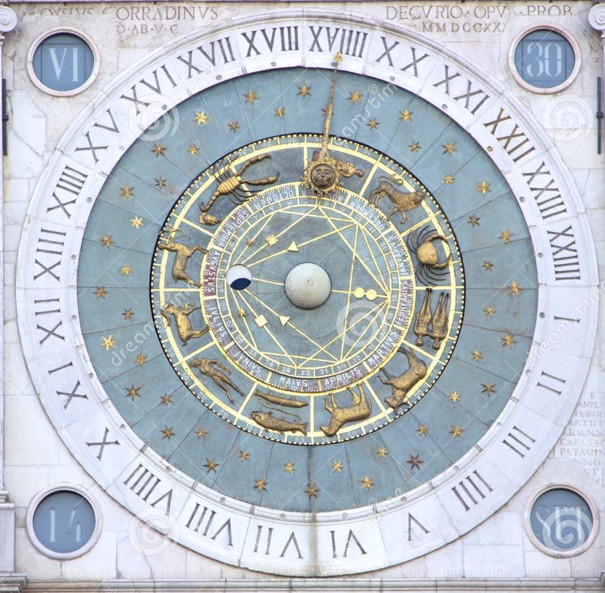
|
Introduction
The Sequence of the Planetary Hours
Planetary Hours & the Names & Sequence of the Days of the Week
Modular Arithmetic, the Planetary Hours & the Days of the Week
The Planetary Third Order
Planetary Third Order & Triplicities
Planetary Minutes
Planetary Seconds
Chaldean & 3rd Planetary Orders and Metals
Introduction
The Sequence of the Planetary Hours
The planetary hours use the Chaldean order to divide time. Each planetary hour of the planetary day is ruled by a different planet. The planet that rules the first hour of the day is also the ruler of the whole day and gives the day its name. Thus the first hour of Sunday is ruled by the Sun, the first hour of Monday is ruled by the Moon and so on.
| Planetary Hours of the Day | |||||||
| Hour | Sunday | Monday | Tuesday | Wednesday | Thursday | Friday | Saturday |
| 1 | Sun | Moon | Mars | Mercury | Jupiter | Venus | Saturn |
| 2 | Venus | Saturn | Sun | Moon | Mars | Mercury | Jupiter |
| 3 | Mercury | Jupiter | Venus | Saturn | Sun | Moon | Mars |
| 4 | Moon | Mars | Mercury | Jupiter | Venus | Saturn | Sun |
| 5 | Saturn | Sun | Moon | Mars | Mercury | Jupiter | Venus |
| 6 | Jupiter | Venus | Saturn | Sun | Moon | Mars | Mercury |
| 7 | Mars | Mercury | Jupiter | Venus | Saturn | Sun | Moon |
| 8 | Sun | Moon | Mars | Mercury | Jupiter | Venus | Saturn |
| 9 | Venus | Saturn | Sun | Moon | Mars | Mercury | Jupiter |
| 10 | Mercury | Jupiter | Venus | Saturn | Sun | Moon | Mars |
| 11 | Moon | Mars | Mercury | Jupiter | Venus | Saturn | Sun |
| 12 | Saturn | Sun | Moon | Mars | Mercury | Jupiter | Venus |
| Planetary Hours of the Night | |||||||
| Hours | Sunday | Monday | Tuesday | Wednesday | Thursday | Friday | Saturday |
| 1 | Jupiter | Venus | Saturn | Sun | Moon | Mars | Mercury |
| 2 | Mars | Mercury | Jupiter | Venus | Saturn | Sun | Moon |
| 3 | Sun | Moon | Mars | Mercury | Jupiter | Venus | Saturn |
| 4 | Venus | Saturn | Sun | Moon | Mars | Mercury | Jupiter |
| 5 | Mercury | Jupiter | Venus | Saturn | Sun | Moon | Mars |
| 6 | Moon | Mars | Mercury | Jupiter | Venus | Saturn | Sun |
| 7 | Saturn | Sun | Moon | Mars | Mercury | Jupiter | Venus |
| 8 | Jupiter | Venus | Saturn | Sun | Moon | Mars | Mercury |
| 9 | Mars | Mercury | Jupiter | Venus | Saturn | Sun | Moon |
| 10 | Sun | Moon | Mars | Mercury | Jupiter | Venus | Saturn |
| 11 | Venus | Saturn | Sun | Moon | Mars | Mercury | Jupiter |
| 12 | Mercury | Jupiter | Venus | Saturn | Sun | Moon | Mars |
However, the planetary hours are not the same as the sixty minute hours beginning at midnight that we use for normal timekeeping. The planetary days are divided into twenty four planetary hours with the first hour of the day beginning at sunrise and the last hour of the day ending at sunrise of the next planetary day. The period that extends from sunrise to sunset (daylight) is divided into twelve hours and the period extending from sunset to sunrise of the next day (nighttime) is also divided into twelve hours giving the twenty four hours of the planetary day.
Accordingly, as the duration of daylight and darkness varies except at the Vernal and Autumnal Equinoxes, on a particular planetary day the length of the hours of the day will differ from the length of the hours of the night. Thus another name for the planetary hours, says William Lilly, the renowned English astrologer, is the unequal hours. Christian Astrology, [London, 1647] page 482.
The Planetary Hours and the Names and Sequence of the Days of the Week
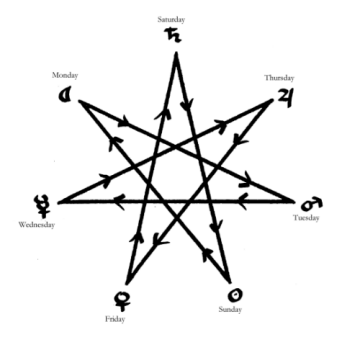
Figure One |
|
As we can see the sequence and names of the days of the week are not in the Chaldean order, but nevertheless the sequence and names of the days of the week are closely connected to the Chaldean order. Two processes interact to produce the sequence of the days of the week: (1) the fact that the planetary hours follow the Chaldean order and; (2) the fact that the planet that rules the first hour of each day rules the whole day and gives the day its name.
Figure One is the standard diagram of the planets arranged in a circle in the Chaldean order. Starting with the Sun and then following the order of the days of the week and their planetary rulers, i.e. Moon, Mars, Mercury, Jupiter, Venus, Saturn, produces a seven pointed star, the heptagram of the week.
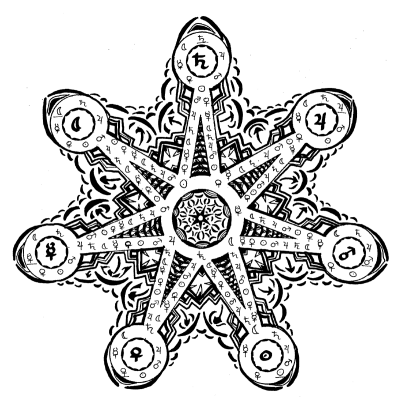
Figure Two |
|
Start with the Sun, the ruler of Sunday. Look for the large bold glyph of the Sun in the lower right hand corner of the diagram. Seven smaller glyphs are arranged around it in a circle. Look in the seven glyphs for the underlined glyph of the Sun. The underlined glyphs indicate the first planetary hour of the day, in this case Sun hour, the first hour of Sunday. The next hour is represented by the glyph of Venus to the left of the underlined glyph of the Sun, thus the second hour of Sunday is ruled by Venus.
So we follow the Chaldean order, from Venus (2nd hour of Sunday) to Mercury (3rd hour of Sunday) to the Moon (4th hour of Sunday), to Saturn (5th hour of Sunday), etc., etc, until we get to the small glyph of Saturn in the inner circle (12th hour of Sunday). Saturn is the ruler of the last hour of daylight on Sunday which ends with sunset. Staying in the inner circle keep going up from Saturn to Jupiter (the 1st hour of Sunday night, beginning with sunset) up to Mars (2nd hour of Sunday night) and then leave the inner circle heading in a straight line to the large Moon glyph, keeping in the Chaldean order by going to the Sun (3rd hour of the night).
We then continue into the circle around the Moon glyph until we reach Mercury which is the ruler of the 12th hour of Sunday night and thus the ruler of the 24th hour of the whole planetary day of Sunday. Therefore we see that the next planetary ruler in the Chaldean order is the Moon, the ruler of the first hour of Monday. By following the diagram in the Chaldean order we can see the interaction of the planetary hours and the names and sequence of the days throughout the week.
Figure Two shows how the sequence of the planetary hours in the Chaldean order and the rulership of the planetary day by the first planetary hour ruler produces the order and names of the days of the week. Thus we can see that the order and names of the days of the week are not merely conventional, but part of an ancient natural and highly ordered astrological system.
Modular Arithmetic, the Planetary Hours & the Days of the Week
In thinking about these various sequences I realized that the key was that they looped and eventually I discovered that they were examples of modular arithmetic. I had never heard of it, but we use it all the time. For example, if it is 1 o'clock and you want to know what time it will be 33 hours from now, we know it will not be 34 o'clock. We would make 2 complete revolutions of 12 hours, ie 24 hours, leaving a remainder of 9 hours. We add the remainder 9 to 1 o'clock and thus we know that if it is 1 o'clock now, that 33 hours from now it will be 10 o'clock. This is modular arithmetic based on 12. For the 7 day Chaldean Order and days of the week sequence we use 7, known as mod 7.
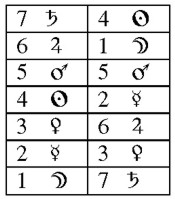
Chaldean Order to Days of the Week +3 mod 7 |
|
Let's do the steps. Look at the diagram "Chaldean Order to Days of the Week" We start on the top left hand column, the Chaldean order column, with 7 & the symbol for Saturn. Go 3 steps down this column from 7 so 6, then 5, then 4 and the Sun. So 4 and the Sun go into the top of the right hand column. This column is the day of the week sequence which starts with Sunday. Go back to 4 on the left hand column, the Chaldean Order, and count 3 again, so 3, 2, then 1, the Moon, which then goes second on the right hand column or Monday. We go back to the right hand column, the Chaldean Order and count 3 again, 7, 6, then 5, Mars. We put 5 and Mars third in the days of the week column for Tuesday. We keep using this +3 mod 7 stepping all the way through the Chaldean Order which then produces the days of the week sequence. +3 mod 7 stepping gives us the essence of the 24 hour steps we used above and merely restates the 24 hour steps in a clearer and more direct expression of the underlying relationships.
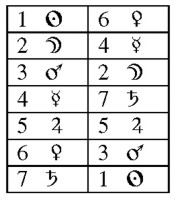
Days of the Week to Chaldean Order +5 mod 7 |
|
So since leap years happen every 4 years and the leap day of February 29th itself is an extra day, we know that we are working with +5 mod 7 steps. So to go from the days of the week to the Chaldean Order we use +5 mod 7 steps.
The Planetary Third Order
Then I got to wondering what would happen if we continue to take these +3 or +5 mod steps. Here is a diagram
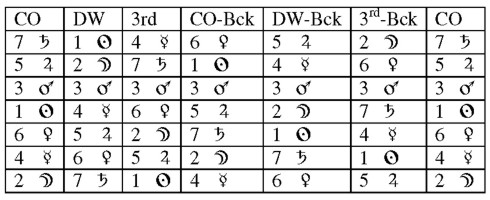
Chaldean Order to Days of the Week and back! +3 mod 7 |
|
So this diagram starts with the Chaldean Order, using the days of the week numbering, just for clarity. Using +3 mod 7 steps it changes from the Chaldean Order to the days of the week and then to a new sequence unknown to me, which I call the planetary 3rd order, then from the planetary 3rd order to the Chaldean Order backwards, then the days of the week backwards, then the 3rd order backwards, then the Chaldean Order in proper order.
What about days of the week to Chaldean Order? Here is a diagram:
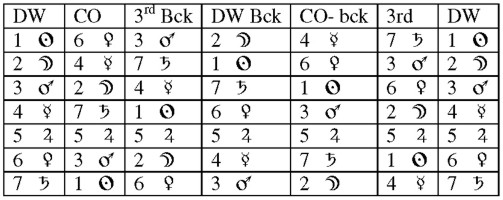
Days of the Week to Chaldean Order and back! +5 mod 7 |
|
So whether we use +3 or +5 stepping in mod 7, there are only three fundamental sequences: the Chaldean Order, the days of the week and the mysterious Third Planetary Order.

Third Planetary Order |
|
To my knowledge none of our traditional sources mention the Third Planetary Order, but nonetheless it is a fundamental and up to now, missing sequence. Once again, we have glimpsed incredible order and connective sympathies naturally underlying what we have taken as a rather ordinary and mundane part of our existence, the days of the week. A very basic cycle and one that whose order appears to have been uninterrupted for over a millenium. Even when the Julian calendary changed to the Gregorian, the order of the days of the week was unchanged. Now, as part of the 7 fold Chaldean Order and days of the week we have the enigmatic Planetary Third Order. What use it may offer for astrological prediction or magical power we do not know, but the power and baffling symmetry of the Cosmos is again revealed.
Planetary Third Order & Triplicities
So after posting the original version of this page I got several very interesting posts and e-mails. The first was a comment on my Renaissance Astrology Blog by a poster named Korami.

Third Planetary Order & Triplicities |
|
They pointed out that the 3rd Planetary Order follows the order of the day and night rulers of the triplicities. Mercury (night ruler of air) then Saturn (day ruler of air) then Mars, the night ruler of water, then Venus, the day ruler of water. Venus is also the day ruler of earth, then the Moon, night ruler of earth, then Jupiter night ruler of fire, then the Sun, day ruler of fire. Alternatively the order could be flipped, so Sun comes first, the day ruler of fire, then Jupiter, night ruler of fire, then Mars, night ruler of water, then Venus, day ruler of water and earth, then Moon night ruler of earth, then Saturn day ruler of air and Mercury night ruler of air. Very interesting! Note below at Chaldean & 3rd Planetary Orders and Metals regarding the atomic numbers of planetary metals and the 3rd Planetary Order.
Planetary Minutes
Then I got a Facebook post and e-mail and several very enlightening diagrams from Claire Pruitt who had already been synchronously working with these orders. She had independently discovered the 3rd planetary order, but had discovered it was the order used for planetary minutes. I found this fascinating, first because she hadn't been working with modular arithmetic and secondly because I found the idea of planetary minutes and seconds very exciting.
So let's add planetary minutes and planetary seconds into our system of planetary hours and days. As we have seen we are working with sequences of 7 planets. We use the days of the week order, not surprisingly for the days of the week. As we go from day to day in the order of the days, we go through the 24 hours. Thus we take 24 steps using one of our three sequences of the 7 planets. As we discovered above using modular arithmetic allows us to see the underlying mathematical sequences at work. 24 in mod 7 equals 3, because we take 3 complete revolutions of the 7 planets, 3 x 7 = 21. If we subtract 21 steps from 24 hours, we have 3 steps left over. Therefore what sequence produces the days of the week order in +3 mod 7 steps? As we have seen above, the Chaldean Order turns into the days of the week order when +3 mod 7 steps are used. So the Chaldean Order is the order of the planetary hours.
Ok, so if the Chaldean Order is the order of the planetary hours, what is the order of the planetary minutes? There are 60 minutes in an hour, so we go through 60 steps to get from one hour to another. 60 equals 4 in modular 7, because eight complete revolutions of 7 planets, 7 x 8, = 56. 60 minutes minus 56 leaves a remainder of 4. 60-56 = 4. So for minutes we use +4 modular steps.
We have not yet worked with +4 mod 7 steps. Here is a diagram:
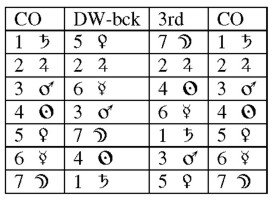
Chaldean Order & back! +4 mod 7 |
|
So if we going through 60 steps (ie +4 mod 7 steps) to get from hour to hour, and the hour sequence is the Chaldean Order, we need to use the 3rd order sequence for planetary minutes. Take a look at the 3rd column which is the 3rd Order when then changes into the 4 column, the Chaldean Order.
The +4 mod 7 step diagram shows the underlying relationship, but let's see the planetary hours and planetary minutes laid out in tabular form. Here is a link to a diagram of the Planetary Minutes. At the top in large font are the planetary hours in Chaldean Order. Directly beneath them is the planet ruling the first minute of the hour, which is the same planet that rules the hour. We start on the far left with Saturn hour, first hour is Saturn, and then we go in the 3rd Planetary Order, starting with Saturn, then Mars, Venus, Moon, Jupiter, Mercury, repeating through 60 steps till we get to the Moon, the ruler of the last minute of Saturn hour. The next planet in the 3rd Planetary Order is Jupiter, all the way up at the top of the 2nd column to the left. Jupiter rules the 1st minute of Jupiter hour, 2nd planet in the Chaldean Order. And so on through the entire 7 planets of the Chaldean Order.
Planetary Seconds
Now let's go further, Claire Pruitt mentioned to me that the planetary seconds are in days of the week order. We can see why this is. There are 60 seconds in a minute, so we are still dealing with +4 mod 7 steps. If planetary minutes are in the 3rd order, then we need the backwards days of the week order, because backwards days of the week order transforms into 3rd order with +4 mod 7 steps. Let's see this in tabular form. Here is a link to a diagram of the Planetary Seconds. At the top are the planetary minutes in the 3rd order. Running down are the planetary seconds in reverse days of the week order. The planet that rules the 1st second of the minute also rules the minute. First minute is ruled by the Moon, then we go in reverse days of the week order, starting with the Moon for sixty seconds and the last second of Moon minute is ruled by Venus, so the next second is all the way at the top of the page, ruled by Jupiter, and as the 1st second of the minute, Jupiter rules the minute. And so on, throughout a complete cycle of 7 planetary minutes.
Very cool! Take a look at these diagrams and tables, they are great for meditation and contemplation. Also I love hearing from others who have discovered more patternings using these sequences.
Chaldean & 3rd Planetary Orders and Metals
I want to again thank Claire Pruitt for additional insights into the cosmic order revealed by these seven fold sequences, this time having to do with the planetary rulership of metals. Here is the standard planetary metals assignment
- Saturn = lead
- Jupiter = tin
- Mars = iron
- Sun = gold
- Venus = copper
- Mercury = mercury
- Moon = silver
The famous medieval astrological grimoire Picatrix Bk II, ch. 10 has Saturn with iron and gold, Jupiter, lead (!!!), Mars, ruby, Venus, red brass, Mercury, mercury, tin, and Moon silver. And Picatrix Bk III, ch 7, says Saturn is lead, Jupiter, tin, Mars, bronze, Sun, gold, Venus gold/silver alloy, Mercury, fixed mercury, Moon, silver.
But using the standard planetary metal rulerships reveals some interesting correspondences pointed out to me by Claire Pruitt. First, let's look at the atomic numbers of these metals. The atomic number is the number of protons in the nucleus of the atom and is the basic ordering mechanism of the periodic table of the elements. Interestingly enough the standard planetary metals in order of their atomic number follow the 3rd Planetary Order:
- Mars (Iron) 26
- Venus (Copper) 29
- Moon (Silver) 47
- Jupiter (Tin) 50
- Sun (Gold) 79
- Mercury (Mercury) 80
- Saturn (Lead) 82
- Moon (Silver) 6.30 x 107
- Venus (Copper) 5.98 x 107
- Sun (Gold) 4.52 x 107
- Mars (Iron) 1.04 x 107
- Jupiter (Tin) 8.7 x 106
- Saturn (Lead) 4.87 x x 106
- Mercury (Mercury) 1.044 x x 106

HOME
Please Contact me for assistance with Orders
Specializing in Horary Astrology, Electional Astrology Astrological Magic and Astrological Talismans.
Copyright 2015 Christopher Warnock, All Rights Reserved.





